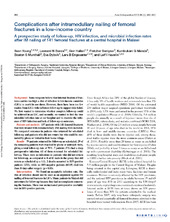| dc.contributor.author | Young, Sven | en_US |
| dc.contributor.author | Banza, Leonard N. | en_US |
| dc.contributor.author | Hallan, Geir | en_US |
| dc.contributor.author | Beniyasi, Fletcher | en_US |
| dc.contributor.author | Manda, Kumbukani G. | en_US |
| dc.contributor.author | Munthali, Boston S. | en_US |
| dc.contributor.author | Dybvik, Eva Hansen | en_US |
| dc.contributor.author | Engesæter, Lars B. | en_US |
| dc.contributor.author | Havelin, Leif Ivar | en_US |
| dc.date.accessioned | 2014-02-10T13:31:44Z | |
| dc.date.available | 2014-02-10T13:31:44Z | |
| dc.date.issued | 2013-10 | eng |
| dc.Published | Acta Orthopaedica 84(5): 460–467 | eng |
| dc.identifier.issn | 1745-3674 | |
| dc.identifier.uri | https://hdl.handle.net/1956/7781 | |
| dc.description.abstract | Background: Some surgeons believe that internal fixation of fractures carries too high a risk of infection in low-income countries (LICs) to merit its use there. However, there have been too few studies from LICs with sufficient follow-up to support this belief. We first wanted to determine whether complete follow-up could be achieved in an LIC, and secondly, we wanted to find the true microbial infection rate at our hospital and to examine the influence of HIV infection and lack of follow-up on outcomes. Patients and methods: 137 patients with 141 femoral fractures that were treated with intramedullary (IM) nailing were included. We compared outcomes in patients who returned for scheduled follow-up and patients who did not return but who could be contacted by phone or visited in their home village. Results: 79 patients returned for follow-up as scheduled; 29 of the remaining patients were reached by phone or outreach visits, giving a total follow-up rate of 79%. 7 patients (5%) had a deep postoperative infection. All of them returned for scheduled follow- up. There were no infections in patients who did not return for follow-up, as compared to 8 of 83 nails in the group that did return as scheduled (p = 0.1). 2 deaths occurred in HIV-positive patients (2/23), while no HIV-negative patients (0/105) died less than 30 days after surgery (p = 0.03). Interpretation: We found an acceptable infection rate. The risk of infection should not be used as an argument against IM nailing of femoral fractures in LICs. Many patients in Malawi did not return for follow-up because they had no complaints concerning the fracture. There was an increased postoperative mortality rate in HIV-positive patients. | en_US |
| dc.language.iso | eng | eng |
| dc.publisher | Informa Healthcare | eng |
| dc.relation.ispartof | <a href="http://hdl.handle.net/1956/7782" target="blank">Orthopaedic Trauma Surgery in Low-Income Countries. Follow-up, Infections and HIV</a> | eng |
| dc.rights | Attribution-NonCommercial CC BY-NC | eng |
| dc.rights.uri | http://creativecommons.org/licenses/by-nc/3.0/ | eng |
| dc.title | Complications after intramedullary nailing of femoral fractures in a low-income country. A prospective study of follow-up, HIV infection, and microbial infection rates after IM nailing of 141 femoral fractures at a central hospital in Malawi | en_US |
| dc.type | Peer reviewed | |
| dc.type | Journal article | |
| dc.description.version | publishedVersion | en_US |
| dc.identifier.doi | https://doi.org/10.3109/17453674.2013.850014 | |
| dc.identifier.cristin | 1092006 | |
| dc.source.journal | Acta Orthopaedica | |
| dc.source.40 | 84 | |
| dc.source.14 | 5 | |
| dc.source.pagenumber | 460-467 | |

